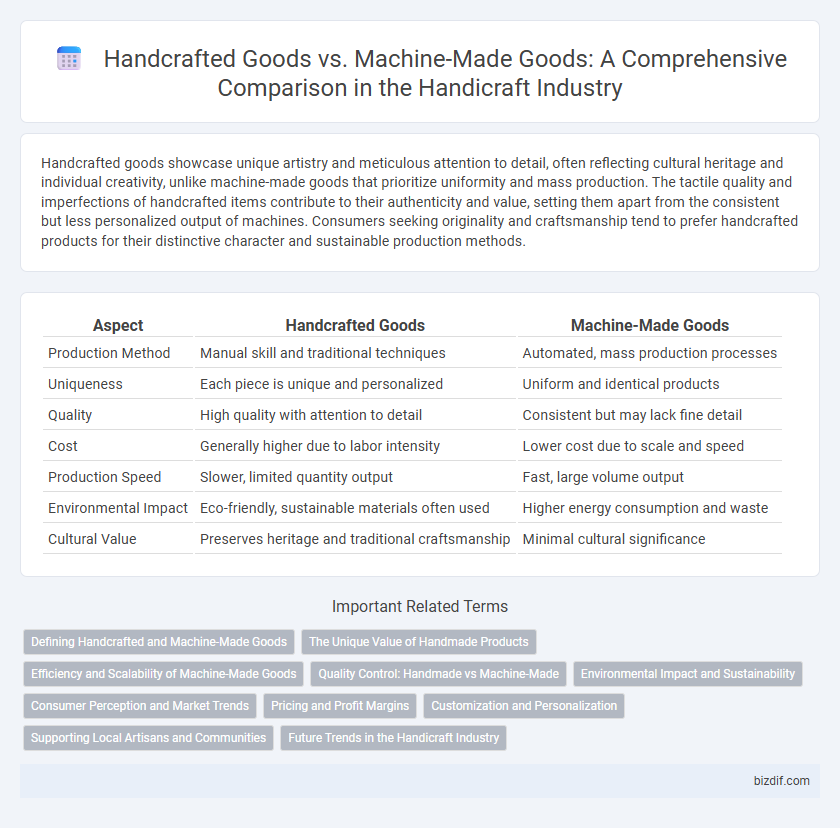Handcrafted goods showcase unique artistry and meticulous attention to detail, often reflecting cultural heritage and individual creativity, unlike machine-made goods that prioritize uniformity and mass production. The tactile quality and imperfections of handcrafted items contribute to their authenticity and value, setting them apart from the consistent but less personalized output of machines. Consumers seeking originality and craftsmanship tend to prefer handcrafted products for their distinctive character and sustainable production methods.
Table of Comparison
| Aspect | Handcrafted Goods | Machine-Made Goods |
|---|---|---|
| Production Method | Manual skill and traditional techniques | Automated, mass production processes |
| Uniqueness | Each piece is unique and personalized | Uniform and identical products |
| Quality | High quality with attention to detail | Consistent but may lack fine detail |
| Cost | Generally higher due to labor intensity | Lower cost due to scale and speed |
| Production Speed | Slower, limited quantity output | Fast, large volume output |
| Environmental Impact | Eco-friendly, sustainable materials often used | Higher energy consumption and waste |
| Cultural Value | Preserves heritage and traditional craftsmanship | Minimal cultural significance |
Defining Handcrafted and Machine-Made Goods
Handcrafted goods are created through skilled manual techniques, emphasizing artistry, individuality, and traditional craftsmanship, often resulting in unique, high-quality items. Machine-made goods are produced using automated processes and machinery, allowing for mass production with uniformity and efficiency but less personal detail. The distinction lies in the level of human involvement and customization, where handcrafted items reflect the artisan's touch, while machine-made products prioritize consistency and scalability.
The Unique Value of Handmade Products
Handmade products embody unparalleled craftsmanship, reflecting the artisan's skill, creativity, and cultural heritage in each piece. Unlike machine-made goods, handcrafted items offer unique imperfections and personalized details that enhance their authenticity and emotional value. Consumers increasingly seek these distinct characteristics, valuing sustainability, originality, and the artisanal story behind each handmade product.
Efficiency and Scalability of Machine-Made Goods
Machine-made goods excel in efficiency due to automated production lines that significantly reduce manufacturing time compared to handcrafted processes. Scalability is another advantage, enabling mass production with consistent quality output to meet large consumer demand. Industrial machinery also lowers per-unit costs and minimizes human error, driving higher productivity in the manufacturing sector.
Quality Control: Handmade vs Machine-Made
Handcrafted goods undergo meticulous quality control through skilled artisans who inspect each detail, ensuring unique imperfections that add character and value. Machine-made goods rely on automated processes and standardized checks, resulting in consistent uniformity but lacking the personalized touch found in handmade items. The quality control in handmade products emphasizes individuality and craftsmanship, whereas machines prioritize efficiency and mass production accuracy.
Environmental Impact and Sustainability
Handcrafted goods generally have a lower environmental impact due to reduced energy consumption and minimal reliance on industrial processes compared to machine-made goods. Artisans often use sustainable materials and traditional techniques that support local ecosystems and reduce waste. Machine-made products typically involve high energy use, mass production of non-biodegradable materials, and generate significant pollution, making handcrafted items a more sustainable choice.
Consumer Perception and Market Trends
Consumer perception often favors handcrafted goods for their uniqueness, superior craftsmanship, and authenticity, leading to a growing niche market that values sustainability and artisanal quality. Machine-made goods dominate in affordability and mass production efficiency, appealing to price-sensitive buyers while sometimes perceived as lacking emotional or cultural value. Market trends indicate a rising demand for handcrafted products in luxury and ethical segments, driven by increased consumer awareness and preference for personalized, eco-friendly, and locally-sourced items.
Pricing and Profit Margins
Handcrafted goods typically command higher prices due to their uniqueness, skilled labor, and limited production volumes, resulting in elevated profit margins for artisans. Machine-made goods benefit from mass production efficiencies, lowering manufacturing costs and retail prices but often yielding narrower profit margins per unit. Consumers increasingly value the authenticity and quality of handcrafted items, allowing sellers to justify premium pricing despite the higher time investment.
Customization and Personalization
Handcrafted goods offer unparalleled customization and personalization, allowing artisans to tailor each piece to specific customer preferences, resulting in unique, one-of-a-kind items. Machine-made goods, while consistent and scalable, lack the intricate detailing and bespoke qualities achievable through manual craftsmanship. Consumers often choose handcrafted products for their distinctiveness and the personal touch embedded in every creation.
Supporting Local Artisans and Communities
Handcrafted goods showcase the unique skills of local artisans, preserving cultural heritage while providing sustainable livelihoods within communities. Supporting handmade products helps strengthen local economies by creating job opportunities and fostering small-scale entrepreneurship. Unlike machine-made goods, handcrafted items offer distinct authenticity and quality, making them valuable symbols of community identity.
Future Trends in the Handicraft Industry
Handcrafted goods are expected to see increased demand as consumers prioritize unique, sustainable, and ethically produced items, distinguishing artisanal quality from mass-produced machine-made goods. Advancements in digital marketing and e-commerce platforms are empowering artisans to reach global markets, expanding the reach of handcrafted products. Integration of technology such as 3D printing may complement traditional techniques, enhancing creativity while preserving the authenticity of handcrafted goods.
Handcrafted Goods vs Machine-Made Goods Infographic

 bizdif.com
bizdif.com